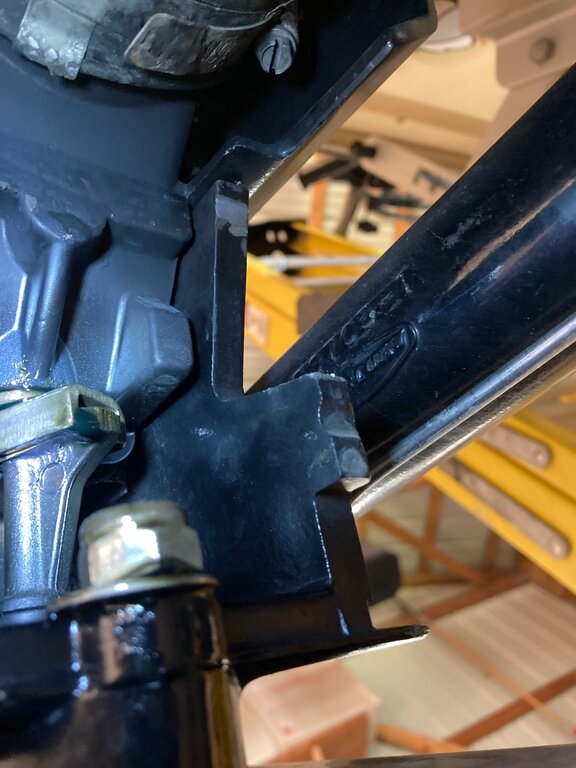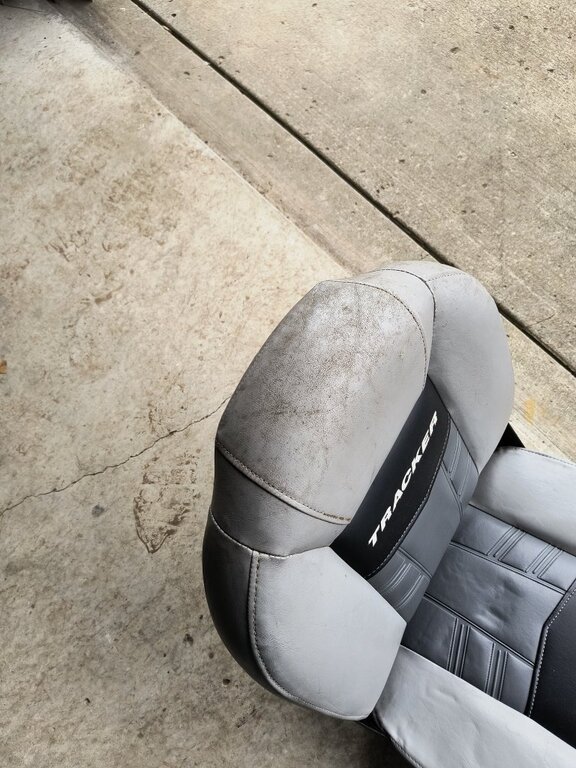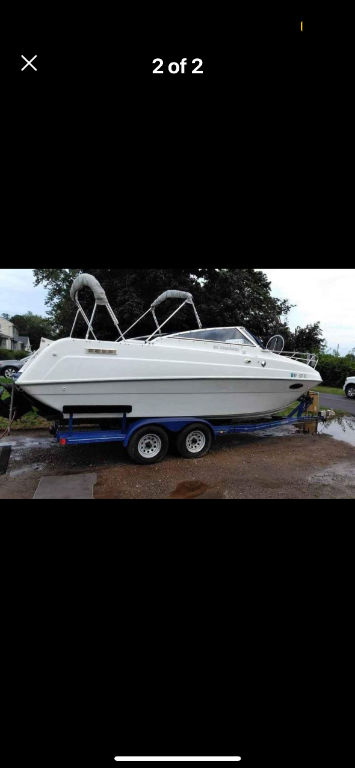

Bozeman Bob
Members-
Posts
902 -
Joined
-
Last visited
Content Type
Profiles
Forums
Events
Gallery
Store
Everything posted by Bozeman Bob
-

Wanted LOOKING FOR A DROP IN 350 OMC MOTOR
Bozeman Bob replied to Hurrikain's topic in Classifieds - Buy, Sell, Trade or Rent
You can buy a 350 GM motor , out of a donor boat or Michiganmotorz.com ( 3500 ,long block ) might have to swap out the flywheel and coupler . Everything else should bolt up , exhaust manifolds , distributer , alternator, starter motor ,carb as long as the " new " motor is a 88 or newer . -
Is this a closed cooling system ? If it's a Mercruiser and closed system there are two raw water pumps , one on the outdrive and one mounted near the bottom of the engine , usually opposite of the alternator. A infrared heat gun would be helpful in pinpointing where the temperature starts to climb above the normal range . Odd that it's only on one side , you might swap risers to see if it's the riser . I know you said it's 3 years old and water is seemingly flowing ok . Unless a hose is clogged,pinched ,that's the number one thing that causes only one side to heat up .
-

ISO Recommendations for Niagara River Guides
Bozeman Bob replied to Slimer's topic in Open Lake Discussion
The only dangerous waters are from the QL bridge and above , heading towards Devils Hole . It can be one cold place to fish , winds screaming down the gorge ,which blocks most of the warming sunlight . Even below the bridge it can be numbing cold . Why subject a toddler to harsh conditions ? Fishing below the bridge itself to the lake the waters are smooth and no manhole size whirlpools to worry about . -
People have put the pink stuff in there freezers and it does freeze . Some mfgs ,if you read the small print , state the freezing point on there product . I would buy regular green anti- freeze and sleep well at night .
-
Just saw this post , hope all went well . Carl has been battling cancer and was out of town recently getting treatments . Prayers for his fight .......
- 1 reply
-
- 1
-

-
I/Os will leak in the bellows and allow water in ,hence the question. Boroscopes will fit through very small openings and some may have a 4' + cable and lighted , that should get you into most of your closed off sections . Or break out the tools and start removing decks , leak isn't going to fix itself. Gluvit is what you want to use for sealing rivets ,check keel for tightness as well.
-
Yes , filling the boat on the trailer is not a good idea and when it's in the water , pressure is applied to the hull and any loose rivets . Is it a outboard or I/O ? Next up is to launch her ,open all access ports and anything else to observe the bottom.of the hull . Might have to buy a boroscope to get into areas that are not visible . Vevor tools has them for around 100 bucks . They articulate at the end , so you can hit a button and it will visually sweep a area up and down . Very clear picture as well .
-

Thompson late 80’s 210 Fisherman collecting water
Bozeman Bob replied to JCG's topic in This Old Boat
First off , I would get under the cover , have someone snap it down, then have that person use a garden hose and figure out where the water is coming in . Then I would take the custom cover back and have it repaired, couldn't off been cheap . You should not have water in the boat if that is a waterproof custom cover , period . I doubt your limber holes were closed off during the repair work , it takes awhile sometimes for the water to make it back to the stern . If they were closed off ,it wouldn't make it to the stern . Not uncommon for the bow area to be the low point of the boat while sitting . You could cut out a section of the floor and install a bilge pump there ,either a access hatch or hinge the piece you cut out . I hope you have a auto float switch and not just a on - off switch ,as you described . That's not a smart way to go with a boat ,unless your covered for sinking because some day you may show up at the dock to see it submerged . -
Yes , buy a ducer that is compatible with the FF . One that has the same number of "pins " or wires . Then buy a Airmar inline cable splice kit .Part # IP 67-10 waterproof connector ,not sure about the hyphen in that number . Ebay is where i bought mine , was 28.00 back a few years , 9/20. Cut the cable ,preferably in a dry , out of the elements location and install the splice connector. It's a pretty sturdy easy to hook up the wires , professional looking connector. No soldering required , good wire stripper and small screwdriver that's it . Or cut your current cable , attach the new cable to it , tape zip ties ,whatever you can come up with . You want it to be as small in diameter as possible and pull it back to the head unit . That's providing the cable isn't zipped tied to something to prevent the connector of the new cable from passing through. Sometimes you can just grab the cable down the line and pull it back and forth and not feel any resistance. If the MFG installed it , it may be secured somewhere. A dealer or someone else , probably not .
-
^^^ , BulletBob yes ,135.00 per hour is on the cheap side, especially for a Marina . Yes they mark items up ,just like auto repair shops , been like that forever. You could bring your own parts in and they will just charge you labor . It's frowned upon and the repair shop will not be responsible for any of your parts warranty or fitting, working properly . Sometimes it cost you more bringing your own parts in , and if they don't fit or work , that's $$$ on you .You are forgetting the shops overhead in your analysis. Everyone knows , Insurance has gone up , what do you think a commercial business pays for that ? Workman's compensation, unemployment comp . , heating cost , electricity, 401K , health insurance, real estate taxes , school taxes , office supplies, office help , service writer , paying a mechanic 30- 35.00 per hour ( Going rate at most garages ) and I'm sure a handful of other things that cut into your actual profit . So a business owner is not sticking 1500.00 into his pocket for one days work .
-
First off , the OPs question should of been before the work was done ,not after . Not any different than someone buying a boat ,then asking if he got a good deal . Secondly, labor rates in the car industry are anywhere from 150 to 200.00 per hour , how does that translate to the marine rate ,which is usually higher . Thirdly we don't know what the exact parts are ,or what they cost . People should ask these forums BEFORE , not after , the work is done or boat is bought , the ship has left the port at this point .
-
MichiganMotorz , has the rebuilt L6 for 2899.00 . Probably the cheapest and quickest drop in replacement. A local engine shop might be another option , they are usually busy now ,car racing season, so be prepared to wait if you go that route .
-
Inboard or I/0 , some people don't know the difference. Straight inboards are easy to work on , extremely reliable and you should get 4 - 6,000 hours out of one that is maintained. They are quiet when trolling , using about a gallon to the hour and typically 1 .2 ---1.6 mpg on a 28-30' rig . That is there big downfall ,along with not being able to trim the bow up as your drive shaft is permanently in a fixed position, so a I/O with the same power and hull will trim out to a much faster speed . The extra weight of the engines low in the hull will mitigate the rocking if in the ditch .I/Os are situated higher up and many ,not all will have a dog house to contend with . Or your deck is sitting a foot or so higher from the water than a inboard model , if it's a flush deck making it a bit harder to handle fish and raising your center of gravity ,,, more rocking . Not going to find many outboard cruisers in that length unless you go newer , like a Parker or a CC . I personally don't like fishing around the outboards vs a clean transom , to each his own .
-
Where did you buy the battery ? Direct from the mfg . ? It may have a dead cell , the charger recognizes that and won't try to charge it . Not sure if your saying the charger has 10-30- 50- 90 - 100 settings and if so how that translates to the battery being charged . Any possibility that you can post picture of charger ,or make and model so we can google it to see exactly what you're dealing with . Same thing with the battery ,make ,model , may help us figure your dilemma out .
-
Most newer battery chargers , like the last decade , will have a setting for the particular type of battery ,lead , lithium, deep cycle are usually what's listed . If it doesn't have that option it more than likely is for lead batteries ,not lithium.
-
Extremely hard to read your post . If I understand what you wrote , my first question , is the charger set up to charge various types of batteries , including Lithium Ion ? If so do you have set in that mode ? What other types of batteries did the charger work on ? Do you have a battery load tester or can you go to a auto repair shop and have it tested along with that shop looking at your charger to make sure it is the correct one for you .
-
**** load of variables, from how hard it's blowing and for how long to how close you are to the source of the currents . If your within 10-20 miles of say the Niagara River dumping into O , it would never affect the deep current . Your by Rochester and it's been blowing hard for a week it may shift the current a bit . Then you have different levels of where the current might start ,say at 50' or maybe 100' if your on the fringe of the main current channel . Current is going to be a lot stronger near the source or outflow ,like Oswego than it will be in the area of the center of it . I'm not a marine hydroligist and could be way off in my take on your question .
-
Does the oil smell like gear oil , there is a distinct difference between engine oil and gear oil . If it's gear oil and seemingly coming from the bellows you have a bad upper seal on the input shaft on the outdrive . If it's engine oil , it's coming out the engines exhaust and you probably have valve seals , piston rings going south . I agree with Chinook on the pressure testing if it's 90 wt gear oil on the ground .
-
Those in-line 6s are bulletproof. Hammer it down ,trim it out and take note of the RPMs . That's the only way to know if you're propped correctly. The only thing I would do is swap it out to a electronic ignition , as in no points ,if it hasn't already been done .
-
Well , you never opened it up and wonder why you're only getting 12 mph ? Seriously ? You could be right below the speed where the boat gets up on a plane and all you're doing is pushing water . Your tach , should be 1 - 200 RPMs ( with your normal load and gas level ) under the Mfg rated ones , which is usually marked on the valve cover , if you're propped correctly. No , pulling the prop is not going to allow you to count gear teeth. You have to pull the outdrive , mark both the drive shaft and prop shaft , spin the drive shaft 365 and note how many times the prop shaft turns with one turn of the drive shaft . Doesn't have to be precise , but should give you a ballpark figure of the gear ratio. Report back after you take it out , run it at WOT and trim the outdrive up to just below where it starts to cavitate . You'll feel or hear the RPMs going up at that point . Going to need the RPM numbers from that test ride . Yes ,3900 - 4300 rpms is the rating , 4100 + would be the sweet spot , below 3900 means you are lugging the engine , working it to death . Generally they try to have you running a 17 -19 pitch prop , so the drives are all geared for that .
-
What size is the new prop vs the old one ? How many RPMs are you getting at WOT ? Are you 100% sure the outdrives are the same ratio ? As in you've spun the prop / prop drive shaft and counted the rotations to at least get a idea that they are the same ratio ?
-

is this mildew ? I need a good cleaner for seats
Bozeman Bob replied to fishing fireman's topic in This Old Boat
-

is this mildew ? I need a good cleaner for seats
Bozeman Bob replied to fishing fireman's topic in This Old Boat
-
What outdrive is on it ? OMC have not been made in decades ,parts are not always easy to find like a Mercruiser over the counter part . Cobra engines I've been told are not that desirable for the same reason . The hull itself ,without seeing if it has a doghouse or the motor is under the deck , isn't something I would be looking at for a fishing boat . Can it be done , yes , bit probably wont be a comfortable boat to fish out of . Where are you mounting the tracks ,downriggers, rod holders etc is something to consider . Boat reg number indicates it's a S Carolina boat ,salt or fresh water ? Stringers and transom need to be verified as solid . Your looking at a 35 year old boat with no knowledge of how its been stored over the years .
-

Prop size for 1997 225 Penn Yan outrage. 4.3 mercruiser
Bozeman Bob replied to Bad Habit's topic in This Old Boat
Fin on lower unit is supposedly designed to keep your boat on a plane at a lower speed . Not to help you get on plane . I don't believe in them ,especially for the size of your boat . If they were the " answer " they would of been integrated into all lower units decades ago . I would pull that off , nothing but drag in your case . Lowering your pitch will NOT negatively affect your top speed , should increase it . Do the math , 21 " prop X 3800 rpm will get you how many inches you traveled ( no prop slip figured in ) Now multiply 19" X 4600 rpms . Not having your exact numbers ,just using this as a example. Your engine is constantly lugging ( wearing out the engine ) right now , know matter the speed and burning more fuel in the process . SS props will be a tad more efficient as the blades don't flex like aluminum will , so less prop slip . Drawback is , you hit something at cruising speed and the prop shaft takes the brunt of the hit , vs the " give " in aluminum. 4 blade will have less slip , smidgen less top end ( drag of extra blade ) and slightly lift the stern of the boat . Probably your best bet if you're constantly leaving port with a full load .




